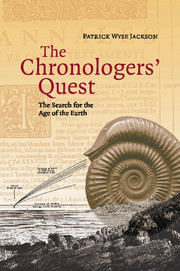Book contents
- Frontmatter
- Contents
- List of illustrations
- List of tables
- Preface
- Acknowledgements
- 1 The ancients: early chronologies
- 2 Biblical calculations
- 3 Models of Aristotelian infinity and sacred theories of the Earth
- 4 Falling stones, salty oceans, and evaporating waters: early empirical measurements of the age of the Earth
- 5 Thinking in layers: early ideas in stratigraphy
- 6 An infinite and cyclical Earth and religious orthodoxy
- 7 The cooling Earth
- 8 Stratigraphical laws, uniformitarianism and the development of the geological column
- 9 ‘Formed stones’ and their subsequent role in biostratigraphy and evolutionary theory
- 10 The hour-glass of accumulated or denuded sediments
- 11 Thermodynamics and the cooling Earth revisited
- 12 Oceanic salination reconsidered
- 13 Radioactivity: invisible geochronometers
- 14 The Universal problem and Duck Soup
- Bibliography
- Index
3 - Models of Aristotelian infinity and sacred theories of the Earth
Published online by Cambridge University Press: 02 December 2009
- Frontmatter
- Contents
- List of illustrations
- List of tables
- Preface
- Acknowledgements
- 1 The ancients: early chronologies
- 2 Biblical calculations
- 3 Models of Aristotelian infinity and sacred theories of the Earth
- 4 Falling stones, salty oceans, and evaporating waters: early empirical measurements of the age of the Earth
- 5 Thinking in layers: early ideas in stratigraphy
- 6 An infinite and cyclical Earth and religious orthodoxy
- 7 The cooling Earth
- 8 Stratigraphical laws, uniformitarianism and the development of the geological column
- 9 ‘Formed stones’ and their subsequent role in biostratigraphy and evolutionary theory
- 10 The hour-glass of accumulated or denuded sediments
- 11 Thermodynamics and the cooling Earth revisited
- 12 Oceanic salination reconsidered
- 13 Radioactivity: invisible geochronometers
- 14 The Universal problem and Duck Soup
- Bibliography
- Index
Summary
Scientific thinking during the seventeenth century was very much influenced by religious belief, dogma and the Scriptures. A number of persons, including some of the cloth, who were for the large part highly educated, began to think about the history of the Earth. But however broad-minded they were, their thinking was constrained by their religious beliefs. Some men, even some Jesuits, were prepared to take some risks with their ideas that could have been interpreted as being counter-religious: it was not long since such men would have been burnt at the stake for heresy.
In Europe in the middle of the seventeenth century, ideas on the nature and history of the Earth began to divide and soon two strands developed. One strand originated with the famous French philosopher René Descartes (1596–1650) and included the German Jesuit priest Athanasius Kircher (1602–1680). They circulated ideas that emphasised the mechanical and chemical processes that they thought explained the features seen on the surface of the Earth, and in some cases they speculated on the nature of its internal workings. To Descartes it was contained in a cycle of Aristotelian infinity in which these dynamic mechanical processes were actually more important than the timescale in which they operated. These thinkers did not really attempt to determine the duration of earthly time, but left this question in a state of openness that reflected the ideas of Aristotle many centuries earlier.
- Type
- Chapter
- Information
- The Chronologers' QuestThe Search for the Age of the Earth, pp. 32 - 46Publisher: Cambridge University PressPrint publication year: 2006



